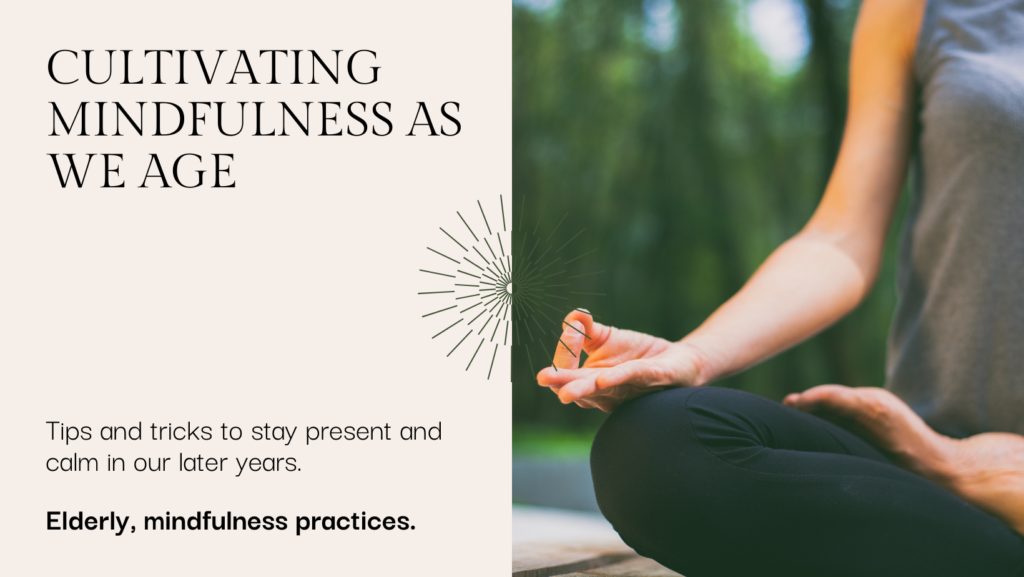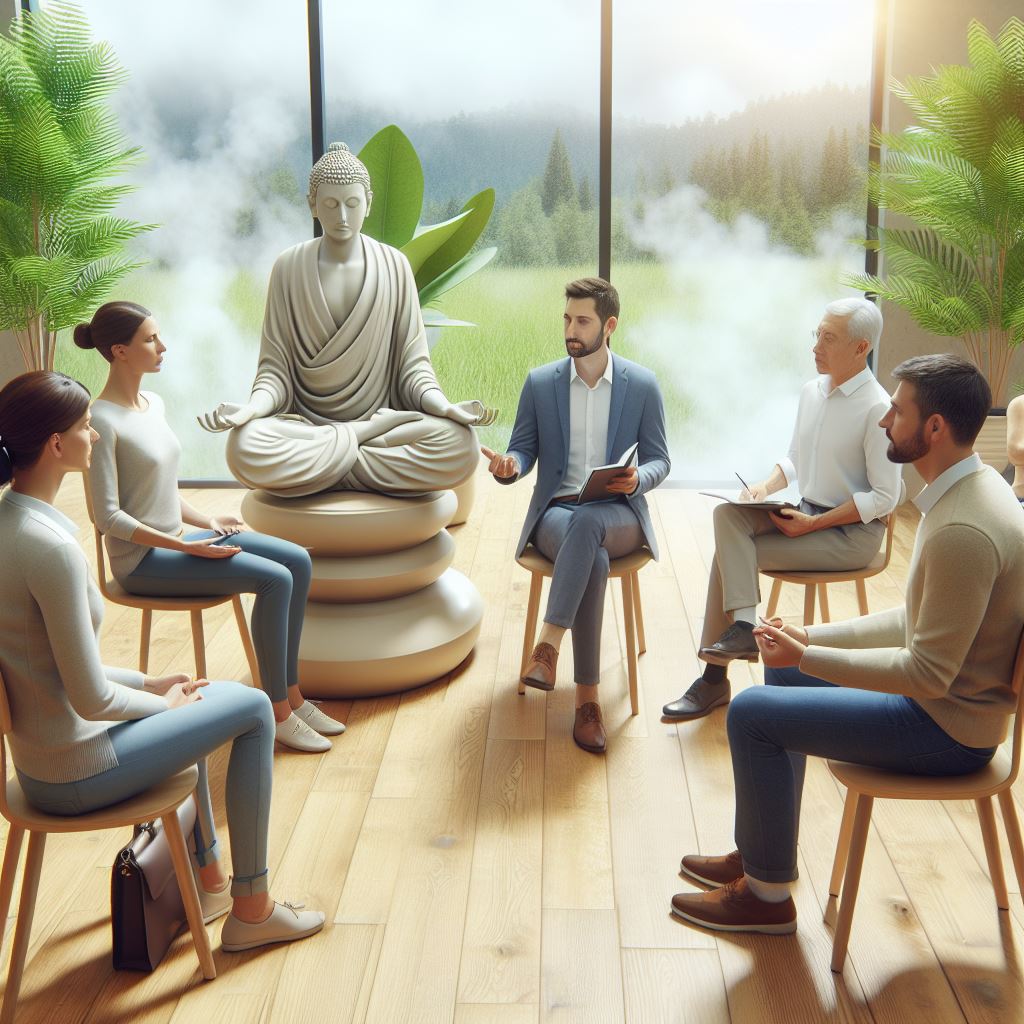
Life is a beautiful journey full of profound moments, and as we grow older, our perception of that journey becomes frankly more “timeless.” We become more aware of the brevity and preciousness of each day. Each is a gift, and we must make them count with joy, purpose, and gratitude. In this blog, we will discuss a practice that is beneficial to aging well while ensuring a fulfilling and relatively relaxed life: mindfulness.
What do we mean when we use the term ‘mindfulness’?
The practice of mindfulness means that we are present and aware in each moment of our lives. We are aware of our thoughts, feelings, bodily sensations, and our environment in the present moment and can observe them without attaching judgment to them. Mindfulness also encourages us to focus on the here and now, rather than dwelling on the past or worrying about the future. Mindfulness is rooted in Buddhism and other contemplative traditions but can be just as easily found and accessed as a secular practice, such as deep breathing, that can be used to promote wellbeing. It is also a valuable stress reduction strategy and can greatly improve your overall sense of mental clarity and a greater connection to life.
Basic equipment to get you started
How can we use mindfulness?
Take time each day to engage in deep breathing exercises, or simply observe the world around you. Mindfulness can help us to see the extraordinary even in the ordinary and can serve to elevate our daily experiences. Ultimately, it can help us improve our mental, emotional, creative, and physical well-being. So, take a moment each day to practice mindfulness. Whether it’s first thing in the morning or over your lunch break, set aside time each day to concentrate on your mindfulness practice.
Cultivating mindfulness can go a long way for overall well-being, but it holds even more value as we get older.
So, if you’re over 50, and looking to embrace mindfulness, here’s are some simple tips for getting started.
Mindfulness is about being fully in the here and now. As you go about your days, practice paying full attention to what’s around you, how your body feels, and what you’re thinking about
That’s right, you can do just about anything mindfully—like savoring a meal, taking a walk, or listening to your favorite music.
This is a great opportunity to tune in to your senses and let your them fully engage.
Can you feel the warmth of the sun on your skin? Do you hear the birds chirping? Let your senses really soak up the sensory experiences around you.
Can you appreciate every little flavor, and savor each delicious bite of food? Slow down as you eat and allow each bite to be a smorgasbord of flavor and texture and scent. Paying attention to hunger and fullness signals may help you avoid mindless eating. Keep screens away at mealtimes. This also works for snacks.
The Body Scan Meditation in a Nutshell

At its core, body scan meditation is a type of mindfulness practice that invites you to focus your attention on various parts of the body in sequence. The practice cultivates a keen and restful awareness of physical sensations and feelings in the body.
To begin this practice, find a quiet spot. Take a moment to lie down comfortably on your back. Close your eyes and mentally follow your breath up and down from head to toe (or toe to head). Tune into any sensations, feelings of tension, and areas of discomfort. As you do so, mindfully inhale and exhale, gradually relaxing each part of the body that you bring to your attention.
Let your breath carry a sense of care and curiosity into each part of your body — including the parts you may find difficult to be with. Acknowledge that your body has its own story to tell and be prepared to witness and hold space for any discomfort you may find. When the meditation is up, gently reawaken the body to the room around you.
More Information on Body Scan Meditation
Remember that this mindfulness practice is meant to be a friendly guide to your experience of your body, and it’s designed to deepen the awareness of your physical form, foster relaxation, and cultivate an overall sense of well-being.
The Path to Mindful Walking

Mindful walking is a practice that invites us to be fully present as we move through the world on foot. Take your mindful walks outdoors. Slow your stride. Be present for each footfall. Feel the earth beneath your feet. Observe the myriad of intricate movements working in concert to keep you upright. Avoid the urge to rush through. Instead, savor each moment. Feel the breeze against your skin, and drink in the views that come into focus. Apply some of the same sense awareness techniques described in the present moment awareness practice. Only devote yourself completely to the walk. Let go of everything else. When your thoughts drift (which they surely will), gently return them to the present moment. Center yourself again with your breath, your steps, or the sensory experiences.
Give some thought to joining a group for mindful walks. Your walk has the potential to deepen when it’s shared with others, and to dissolve the sense of separateness that exists between you. Keep in mind that mindful walking is not about reaching a destination, it is about truly appreciating each step, breath, and the profound splendor of your present moment.
Related: Product Recommendations and Gifts for Men
Gratitude Practice

Gratitude practice is a powerful way to boost our well-being and cultivate positive emotions. By intentionally focusing on what we appreciate, we can experience more happiness along with healthy and fulfilling relationships, which can bring overall life satisfaction. One way to do this is through gratitude journaling, which involves simply writing down things we are grateful for. You can also express gratitude by writing thank you notes, or by simply expressing thanks, in your own way. Keep a journal and write down three new things that you are grateful for each day. The key to this experience is to reflect on why they happened and how they made you feel. Eat mindfully, and before each meal pause and reflect on everything that went into that meal, from the planting of the seed to the finished product that has arrived on your plate.
Gratitude Journals to Try
Cultivate a grateful heart, and this will naturally deepen your connection to the present moment. And remember, gratitude is practice. It’s a muscle that we must build over time. Start small and incorporate one of these exercises into your day. Once it feels integrated, add another one. Be consistent and watch how gratitude transforms your life.
Mindful Social Connections

Mindful social connections greatly affect our overall well-being and happiness. When we cultivate our interactions with awareness and understanding, we strengthen our connections and create meaningful relationships. Engage in meaningful conversations with others. When in conversation make sure to really listen. Be there. Put away the phones. Make eye contact. Be invested. Mindful listening enables us to attribute more empathy and understanding of the other person. Pay attention to your energy levels around friends. If you need to decline an invitation to have some personal time to yourself, it’s okay. It’s important to know your limits.
Being true to yourself is crucial for these interactions to be fulfilling and sustainable. Be Open and Vulnerable. Authentically connecting to the people, you care for is most essential. Share your thoughts, feelings, and experiences. Vulnerability allows for others to connect to your humanity. Finally, appreciate the little moments. Celebrate another year or accomplishments with friends and family. They’ll appreciate it. It’s another moment to be together strengthening your bond. These mindful social connections involve being present, listening actively, and nurturing within intentionality. Quality over quantity always.
Mindfulness Retreats

Mindfulness retreats offer a unique opportunity to deepen your mindfulness practice, or to begin exploring mindfulness. This is a dedicated time to deepen your practice and learn from experienced teachers! Some of the benefits of attending a Mindfulness Retreat are having an immersive, dedicated environment away from daily distractions, practicing for longer periods of time (this really helps when you come back to the real world and want to get in a few minutes of mindfulness practice!), learning from instructors who offer tools, techniques, and personalized guidance, and create a safe space for exploration and self-discovery. Retreats can also offer a mix of practices, including meditation, mindful walking, body scans, and yoga, allowing you to explore what resonates with you.
Six Mindfulness Retreat Options
Mindfulness Retreats can be a transformative experience — for beginners and those looking to deepen their practice alike. You might start by clicking the above list of options or online retreats, and find one that meets your needs, interests, and budget.

Remember, mindfulness is a lifelong journey. Also, recognize that not every activity has to be fully mindful. Sometimes you must walk fast, either to get somewhere or to get your heart rate up for better heart health/fitness. Start small, be patient with yourself, and with time, incorporate these practices into your life with time allocated in a way that makes sense for you. The benefits — such as reduced stress, increased emotional well-being, and better physical health — are well worth the effort.

Pingback: Mindfulness Retreats: A Journey to Your Inner Self -
Pingback: Retirement Lifestyle Plan: Start Now -